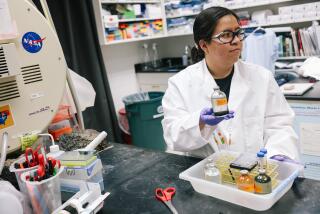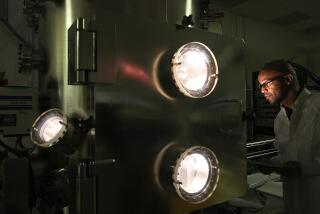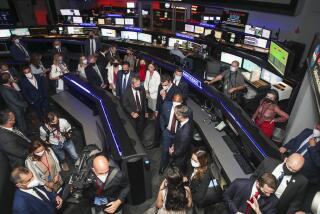SAN JUAN CAPISTRANO : Institute May Get More Suitable Home
So far, Douglas Nash’s dream of paving mankind’s way to the stars and solving worldwide ecological problems such as global warming has run up against a rather basic reality.
It’s hard to help save the world from a cramped suite of offices in a local business park.
That is where Nash a operates the nationally recognized San Juan Capistrano Research Institute, which is working with NASA scientists to send an unmanned probe to the moon. But the institute lacks enough space on Earth.
Tonight, Nash’s dream may find a home as the City Council considers whether to lease a building that would become headquarters for the science institute.
If approved, the city would lease a 10,000-square-foot building, formerly occupied by Bank of America, and sublet about half of it to the research institute.
“Hopefully, we will grow,” said Nash, a scientist with the Jet Propulsion Laboratory in Pasadena for 28 years and a former mayor of this city. “This will only be the start. We hope to put San Juan Capistrano on the map for more than swallows.”
The institute is funded through a $63,000 NASA grant and private donations to address global issues such as thinning of the ozone layer, carbon dioxide buildup in the atmosphere and acid rain, Nash said. And in two weeks, Nash’s institute will be hosting a meeting of NASA scientists in San Juan Capistrano who hope to survey and map the moon by 1996 in preparation for a permanent base, which eventually would serve “as a steppingstone to Mars,” Nash said.
“We will map the entire surface of the moon and measure factors like the composition and topography of the moon’s surface in order to choose a site for the base,” he explained.
“It’s a precursor to the return of men to the moon.”
Nash, who is employed part time at JPL, is in charge of organizing what will eventually become a group of hundreds of scientists working on the moon project.
His institute won national attention last year when it published an article in the trade journal Science. The prestigious publication printed the institute’s discovery of a gas on Io, a moon of Jupiter, which previously was known to exist only in the Earth’s atmosphere.
The institute has been warmly supported by the City Council, which has passed a resolution of support and a grant for $15,000 since 1986, when Nash first proposed the institute.
Councilman Kenneth E. Friess said he envisions a day when the institute could parallel the growth of the Jet Propulsion Laboratory, which hires thousands of employees in the aerospace-research field.
“We want that kind of industry in San Juan Capistrano,” he said, adding that a prominent research facility could also attract a small, four-year college.
City officials say they also have plans for the building. The city hopes to turn the former bank into an exhibit hall for early California Indian artifacts found in archeological digs near the Mission San Juan Capistrano in 1988, Mayor Gary L. Hausdorfer said.
“I see it as the museum concept that we’ve been looking for for a long time,” he added.
The exhibit hall could be ready by March, in time for the city’s annual springtime Heritage Festival. The first display will feature a NASA science exhibit that will include moon rock samples, Hausdorfer said.






